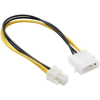Building a new mini-itx based firewall. Trying to keep it low power, it is running at about ~30W (A2SDi-4C-HLN4F, dual Solarflare 10G, 16GB RAM, NVMe storage). The current power supply is a regular ATX PSU which is outside of the case.
For the final build I would like something more integrated;
-I know about PICO PSU, but dislike the external 12V power brick, and the fact that there is no nice way to secure the barrel plug on the case.
-Flex ATX seems like overkill in power, heat/noise, and cost.
Are there any different options? How about PICO PSU and mouting the power brick inside the case (I think a brick is smaller than Flex ATX)?
For the final build I would like something more integrated;
-I know about PICO PSU, but dislike the external 12V power brick, and the fact that there is no nice way to secure the barrel plug on the case.
-Flex ATX seems like overkill in power, heat/noise, and cost.
Are there any different options? How about PICO PSU and mouting the power brick inside the case (I think a brick is smaller than Flex ATX)?


